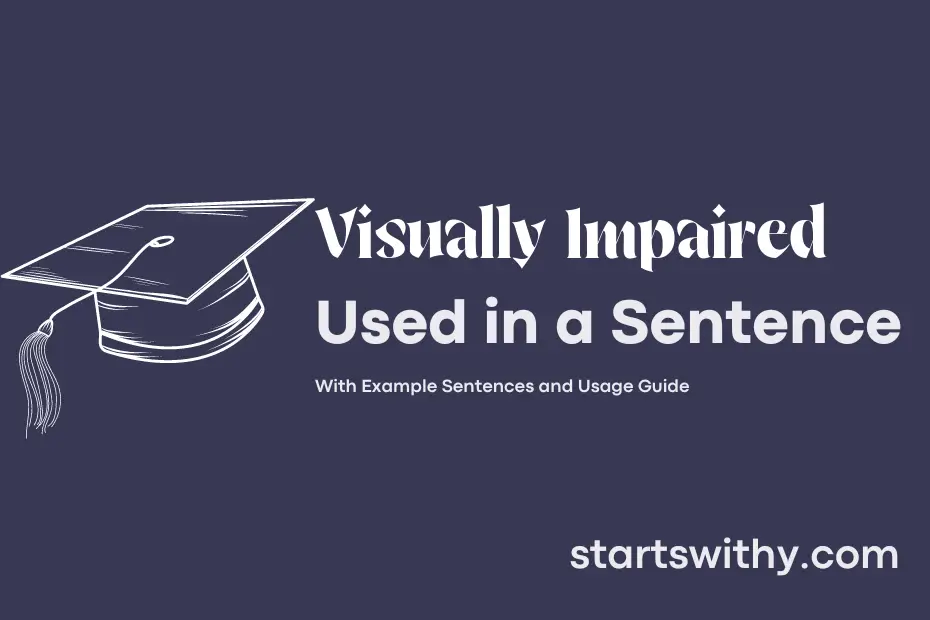Have you ever wondered how to communicate effectively with individuals who are visually impaired? People who are visually impaired have varying degrees of sight loss, ranging from partial to total blindness. This condition can pose challenges in daily interactions, making it important to understand how to engage with them respectfully and empathetically.
Being visually impaired means having limited or no ability to see, affecting individuals’ daily activities and interactions. Navigating the world without full sight requires reliance on other senses and adaptive techniques. Understanding how to provide assistance and communicate clearly with visually impaired individuals is essential for creating an inclusive and supportive environment.
7 Examples Of Visually Impaired Used In a Sentence For Kids
- We can help visually impaired people by being kind and offering assistance.
- Visually impaired individuals may use a white cane to help them navigate safely.
- Books in braille are designed for people who are visually impaired.
- Guide dogs are specially trained to assist visually impaired individuals.
- It is important to speak clearly when communicating with someone who is visually impaired.
- Visually impaired individuals may use special software to read text on the computer.
- Let’s be understanding and patient with our visually impaired friends.
14 Sentences with Visually Impaired Examples
- Visually impaired students in India can benefit from access to educational resources in Braille.
- College campuses should offer specialized technology to assist visually impaired students in their studies.
- It is important for professors to provide accommodations for visually impaired students during lectures and exams.
- Visually impaired students may require extra time to complete assignments or exams.
- College libraries should have materials available in audio format for visually impaired students.
- Visually impaired students can benefit from campus orientation programs that help them navigate the college environment.
- Peer tutors can assist visually impaired students with their coursework and assignments.
- College events and activities should be inclusive and accessible to visually impaired students.
- Professors should be aware of the needs of visually impaired students and make sure their presentations are accessible.
- Students should be mindful of visually impaired classmates and offer assistance when needed.
- Visually impaired students may benefit from participation in support groups on campus.
- College campuses should have designated study spaces equipped for visually impaired students.
- Student organizations can advocate for the rights and accommodations of visually impaired students on campus.
- It is important for college staff to undergo sensitivity training to better understand and support visually impaired students.
How To Use Visually Impaired in Sentences?
Visually Impaired refers to individuals who have difficulty seeing clearly or are blind. When incorporating Visually Impaired into a sentence, it is important to follow certain guidelines:
-
Use proper language: Instead of saying “the blind,” which can be seen as dehumanizing, opt for “Visually Impaired individuals” or “people who are Visually Impaired.”
-
Be descriptive: When using Visually Impaired in a sentence, provide context or details to enhance understanding. For example, “The museum offers guided tours for Visually Impaired visitors.”
-
Show respect: Treat individuals who are Visually Impaired with respect by using language that is inclusive and considerate.
-
Avoid making assumptions: Do not assume limitations based on a person’s visual impairment. Instead, focus on their abilities and strengths.
-
Consider accessibility: When writing or speaking about Visually Impaired individuals, consider accessibility factors such as providing alternative formats like braille or audio descriptions.
By following these guidelines, you can effectively and respectfully incorporate Visually Impaired into your communication to ensure understanding and sensitivity towards individuals with visual impairments.
Conclusion
In conclusion, designing materials and environments with the needs of visually impaired individuals in mind is crucial for promoting inclusivity and accessibility. By incorporating features such as braille signage, auditory cues, and tactile maps, spaces can become more navigable and user-friendly for those with visual impairments. Additionally, providing audio descriptions and ensuring digital content is screen-reader friendly can enhance the overall accessibility of information for this demographic.
It is essential for society to recognize and accommodate the diverse needs of visually impaired individuals to ensure they can fully participate in all aspects of life. Through thoughtful design and consideration, we can create more inclusive environments that benefit everyone, regardless of their level of visual impairment.



